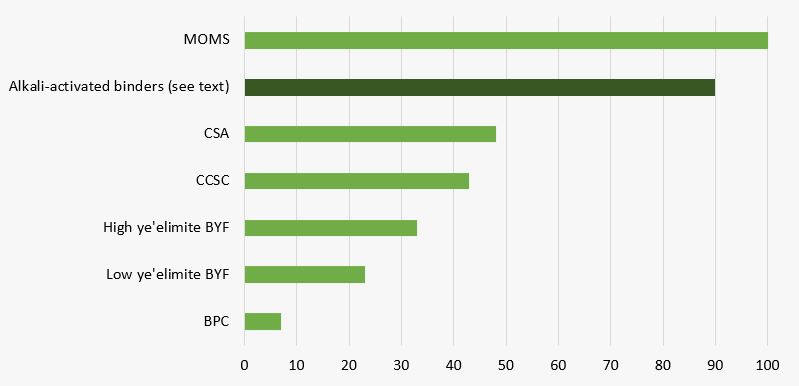Is Green Cement Making Concrete Progress?
06 Aug 20214 Minute Read

Building on the Paris Agreement, theUK Government has recently announced targets to reduce UK net greenhouse gas emissions by 78% by 2035 compared with 1990 levels. With the built environment responsible for 40% of the UK’s carbon footprint
,there is an increasing acceptance that in order to reach these targets, the way in which we build needs to change.
A key substance responsible for carbon emissions in construction is cement .The chemical and thermal combustion process involved in the production of cement results in a large amount of carbon dioxide (CO2) being released into the atmosphere, responsible foraround 8% of the world's carbon dioxide emissions .Yet there is no escaping that cement will continue to be an integral part of the built environment,with global cement production set to increase by over 1 billion tonnes a year, from 4bn to over 5bn tonnes, over the next 30 years.If so, the industry needs to adapt and innovate, transforming the production of cement to reduce carbon emissions.
One way this can be done is using ‘green’ alternatives such as Geopolymer Cement (GPC). While the conventional method of mixing cement involves calcium and silicon,GPC removes the need for these components and instead uses industrial waste materials such as fly ash which is then alkali activated .Studies have shown in using this method, GPC reduces CO2 emissions up to 80-90%. This reduction compares extremely well with other alternatives to ordinary cement, as Chart 1 shows.
Chart 1: Cement alternatives, potential % reduction in process emissions

Source: Chatham House Report, Making Concrete Change: Innovation in Low-carbon Cement and Concrete, 2018. For alkali-activated binders, the estimated maximum reduction is shown.
While most ‘novel’ cements have not been in use long enough to be tested and regulated, GPC has been the focus of studies since the 1970s and formed part ofhigh-profile projects such as Brisbane West Wellcamp airport .Tests have shown the material has several advantages over traditional cement such as strength, durability, low shrinkage, fire resistant and additional thermal insultation.
Nevertheless, there are technical barriers preventing widespread application. Whilst GPC is relatively cheap to make,commentators note the industry has been slow to accept the product due to the expense attached to changing manufacturing plants .Supply of raw material creates a further barrier, and where supplies of raw materials are available, the effects of transportation should be considered in the carbon footprint of construction.
远离传统的方法来创建一个more sustainable way of building is no doubt an innovation that the construction industry would benefit from being associated with. The potential to drastically reduce carbon emissions by use of GPC will support a higher BREEAM score under the energy and innovation category for any scheme and create a more attractive development for the carbon conscious.
While it may appear risky to incorporate, GPC is already considered a competitor to traditional concrete, and with many larger listed players increasingly setting specific targets in reducing their carbon footprint, we may see GPC and other green alternatives being increasingly looked to for the answer.
A key substance responsible for carbon emissions in construction is cement .The chemical and thermal combustion process involved in the production of cement results in a large amount of carbon dioxide (CO2) being released into the atmosphere, responsible foraround 8% of the world's carbon dioxide emissions .Yet there is no escaping that cement will continue to be an integral part of the built environment,with global cement production set to increase by over 1 billion tonnes a year, from 4bn to over 5bn tonnes, over the next 30 years.If so, the industry needs to adapt and innovate, transforming the production of cement to reduce carbon emissions.
One way this can be done is using ‘green’ alternatives such as Geopolymer Cement (GPC). While the conventional method of mixing cement involves calcium and silicon,GPC removes the need for these components and instead uses industrial waste materials such as fly ash which is then alkali activated .Studies have shown in using this method, GPC reduces CO2 emissions up to 80-90%. This reduction compares extremely well with other alternatives to ordinary cement, as Chart 1 shows.
Chart 1: Cement alternatives, potential % reduction in process emissions

Source: Chatham House Report, Making Concrete Change: Innovation in Low-carbon Cement and Concrete, 2018. For alkali-activated binders, the estimated maximum reduction is shown.
While most ‘novel’ cements have not been in use long enough to be tested and regulated, GPC has been the focus of studies since the 1970s and formed part ofhigh-profile projects such as Brisbane West Wellcamp airport .Tests have shown the material has several advantages over traditional cement such as strength, durability, low shrinkage, fire resistant and additional thermal insultation.
Nevertheless, there are technical barriers preventing widespread application. Whilst GPC is relatively cheap to make,commentators note the industry has been slow to accept the product due to the expense attached to changing manufacturing plants .Supply of raw material creates a further barrier, and where supplies of raw materials are available, the effects of transportation should be considered in the carbon footprint of construction.
远离传统的方法来创建一个more sustainable way of building is no doubt an innovation that the construction industry would benefit from being associated with. The potential to drastically reduce carbon emissions by use of GPC will support a higher BREEAM score under the energy and innovation category for any scheme and create a more attractive development for the carbon conscious.
While it may appear risky to incorporate, GPC is already considered a competitor to traditional concrete, and with many larger listed players increasingly setting specific targets in reducing their carbon footprint, we may see GPC and other green alternatives being increasingly looked to for the answer.
Further Reading
Create the Real Estate Solutions of Tomorrow
Unlock the value in every dimension of your real estate with integrated, data-led services that support your overall business strategy.

